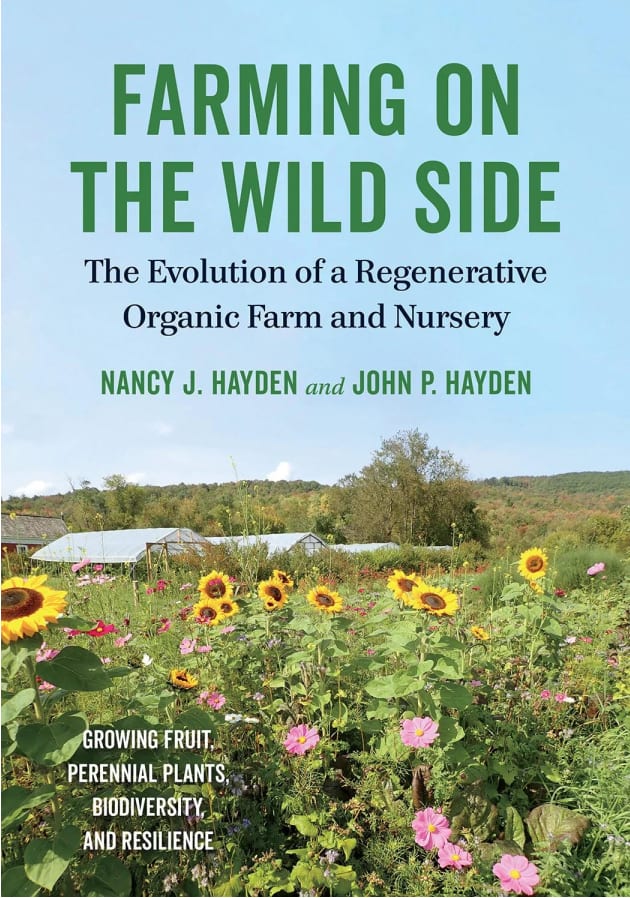Farming on the Wild Side: The Evolution of a Regenerative Organic Farm and Nursery

Written by Nancy J. Hayden and John P. Hayden
Published by Chelsea Green Publishing, 2019
Reviewed by Lucy Birkett
Farming on the Wild Side chronicles, in a most delightful and humble way, the progression of a small organic farm in northern Vermont. At the helm are an entomologist and an environmental engineer who make nurturing biodiversity a top priority as they transform an old dairy farm into a productive, thriving, diversified farm teeming with life, while supporting their family and community over the course of decades. Lest the farm sound perfect, it is not; the book is realistic, and it’s very much about the impermanent nature of life. The authors convey their own trials and tribulations with honesty, generosity and good humor. The entire book is interspersed with moments of poignant philosophical wisdom, and ecology is everywhere.
Nancy and John Hayden set out to farm with nature rather than against it, placing family and community within the farm ecosystem. Their partnership for this is ideal and their commitment is strong. Nancy is an environmental engineer and professor of civil engineering at UVM, and John is an entomologist who had specialized in the ecology of apple pests, IPM, and worked with farmers. They know a lot about the cyclical trap of pesticides, how the toxicity has a ripple effect on insects and other organisms in soils and beyond, and the Haydens are motivated to learn from and work with the insects and maximize the functions of the ecosystem to benefit the whole farm.
The book is full of specific examples of how they nurture the farm ecosystem, but much of it comes down to their relationships with the land, workers, wildlife, neighbors, insects. They celebrate some successes, and many lessons learned, offering practical and detailed advice all along the way. In addition to taking cues from the natural world, they are constantly responding to economic markets, climate change, and the ever-evolving needs and resources of their family and community.
In a grounding first chapter, the authors describe their daily practice of walking the farm “to provide a slow close-up view to the natural world and keep in touch with plants, animals, weather, and the many happenings at the farm.” It’s a clue into the respect that they give themselves and the farm as they approach the work of the day.
Each chapter that follows reads like a journey, as the authors bring us along on a story of something they did or tried at their farm, and what they learned in the process. They’ve skillfully woven themes such as soil, adapting to climate change, pests, fruit and nut trees, and pollinators into all their stories, or perhaps it’s the other way around, but in any case, it makes for a pleasant flow. Photos large and small dot the pages as part of the celebration of biodiversity and life on this farm.
I must admit that when opening this book, the two things that were most on my mind were: Is this farm financially viable (i.e. is this real?)? And what is their perspective on invasive species? The Haydens did not shy away from these topics, and I am grateful for the honesty with which they addressed them. Financial challenges and solutions including off-farm jobs and “small farm flexibility” are acknowledged throughout the book. As to the invasive question, I’d like to point the entire world to the chapter called “Rethinking pests, invasive species, and other paradigms” in which they offer strong opinions based on science (which they explain) and their own observations (which they describe), and their ethic (which is respect for all beings). Practiced and practical advice here is detailed, realistic, and honest. They aren’t saying it’s simple or easy, but they offer plenty of fascinating and inspiring specifics, illustrating how learning about, respecting, and utilizing the ecology has helped them to make smarter and lighter management choices.
This is a joyful book about trying stuff, paying attention, entrepreneurship, and living fully as a member of the natural world no matter where we live. By freely sharing their experiences as they find their way as farmers, the Haydens demonstrate that by adjusting our attitude or our attention here or there, we have the potential to affect changes in our ecosystems that will generate more life and abundance. As far as my question “is this real?” – not much is as real as this.
About the Reviewer
Lucy Birkett is an ecology enthusiast and native plant gardener who consults in ecosystem gardening in southern and mid-coast Maine. She also works on an organic fruit and vegetable farm and enjoys growing as many native tree, shrub and herb species from seed as she is able. Her favorite thing is to introduce community members and clients to the plants and insects with whom they live.
***
Each author appearing herein retains original copyright. Right to reproduce or disseminate all material herein, including to Columbia University Library’s CAUSEWAY Project, is otherwise reserved by ELA. Please contact ELA for permission to reprint.
Mention of products is not intended to constitute endorsement. Opinions expressed in this newsletter article do not necessarily represent those of ELA’s directors, staff, or members.

